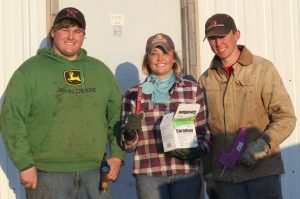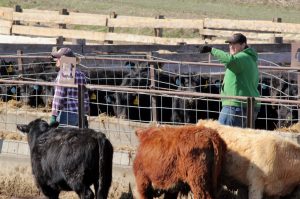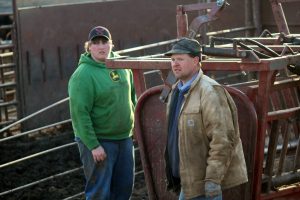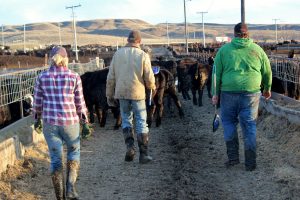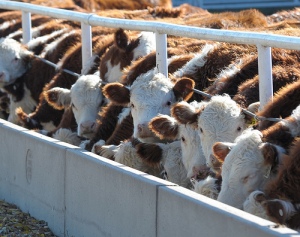
Part 2: Beta-agonists, the Environment and Cattle Feed Intake. After analyzing feed intake data from three feedlots that used Zilmax in their rations, Chris Reinhardt, K-State feedlot specialist, found that cattle fell off on feed intake more in the summer months compared to any other time of year, and the cattle that were consuming more feed prior to the initiation of Zilmax not only had a much higher likelihood of losing intake but the size of the intake drop-off was larger. Click image for original story.
In this part 2 of a two-part series, a K-State feedlot specialist provides a look into how environmental factors, including heat stress, coupled with the use of beta-agonists potentially affects cattle feed intake. See Part 1 here.
MANHATTAN, Kan. – Growing cattle that are more efficient in converting feed to muscle is a main goal in the beef industry. Many cattle producers, feedlot operators and researchers strive to use genetics and modern feedlot technologies to continuously improve that efficiency.
Chris Reinhardt, feedlot specialist for Kansas State University, is one of those researchers seeking to find solutions to improve efficiency in cattle production. Reinhardt has looked specifically at how beta-agonists, a cattle feed supplement approved by the U.S. Food and Drug Administration and considered safe from a food safety perspective, improve the cattle’s natural ability to convert feed into more lean muscle.
“Beta-agonists increase the deposition of lean muscle on the carcass,” Reinhardt said. “They make cattle more efficient at converting grain to muscle. They also improve the efficiency of converting an animal carcass into sellable meat.”
Zilmax, formally known as zilpaterol hydrochloride, is one of only two beta-agonists approved for cattle feeding on the market. However, Merck Animal Health, manufacturer of Zilmax, voluntarily suspended sales of the product last September when major U.S. meat packer Tyson announced it would stop buying cattle fed Zilmax due to an animal welfare concern, which questioned if the product affected the ambulatory ability, or movement, of cattle.
There has been no direct link established between the use Zilmax and impaired cattle mobility, Reinhardt said. Cattle fatigue syndrome may be caused by many factors, such as summer heat, and exertion prior to harvest. But, studying the reasons behind stiff-muscled and tired cattle, and if beta-agonists play a role, isn’t the only angle of research being examined. Reinhardt has been looking more closely to see if beta-agonists, particularly Zilmax, affect cattle feed intake.
“Over the past few years, on certain occasions, feedlots have seen where Zilmax was started in the feed, and cattle would fall off on intake,” Reinhardt said. “Sometimes the intake would come back to normal, and sometimes it wouldn’t. Because Zilmax is a growth promotant, if we’re losing some of the dry matter intake and some of the energy intake, are we getting full value for that growth promotant?”
Reinhardt has looked at data from three separate commercial feedlots over the past three years and studied some of the differences in feed intake in 1,100 pens of cattle. He looked at the dry matter intake prior to and through the end of the cattle-feeding period. He compared this to the time when Zilmax was brought into the feed rations, the sex and weight of the cattle, and the location of the feedlot, to try to filter out any common factors when the cattle did or did not lose feed intake.
The data analysis uncovered two main findings. First, season played a role in the drop-off in feed intake. Second, cattle that were consuming more feed prior to the initiation of Zilmax had a much higher likelihood of losing intake, and the size of the intake drop-off was larger.
“The drop-off was quite a bit larger in the summertime than in the other seasons,” Reinhardt said. “In spring and fall, there was very little change in intake. What pens did fall off on intake for the most part actually recovered back to normal.”
Reinhardt said this could mean weather and season, particularly heat, plays a factor in cattle’s response to beta-agonists. Surprisingly, the winter months showed more of a drop-off on intake overall compared to spring and fall, and Reinhardt said this issue, perhaps due to cold stress, must be looked at more closely as well.
On the issue surrounding big-eating cattle falling off more on intake once Zilmax was initiated, Reinhardt said it could be because the cattle that are eating more feed are also eating more of the drug.
“Really we don’t know the economic impact from these intake losses,” Reinhardt said. “We do know that some pens of cattle were more subject to loss of intake than other groups. The question is, is it economical to continue to use the beta-agonist even though you’re seeing a decrease in intake, or should the decision be made in extremely warm weather to not use the drug for a period of weeks until the weather abates?”
Advice for feedlot operators
Reinhardt said it will take more research to make specific recommendations on using beta-agonists to cattle feeders, but this initial research is one step closer to understanding how environmental factors, combined with the use of beta-agonists, might affect cattle feeding.
While Merck recently announced that it is too early to determine when Zilmax will return to the market (Merck Animal Health Shares Progress on Zilmax and the Five-Step Plan for Responsible Beef), many feedlots might have switched to using a competing beta-agonist called Optaflexx, or ractopamine. The transition from one product to another, Reinhardt said, hasn’t been a huge challenge for many feedlot operators, but he said the products do work differently. More research needs to be done to further understand how all beta-agonists on the market work in cattle feeding.
“Knowledge is power, and I hope we continue to have the opportunity to utilize technologies in our feedlot community,” Reinhardt said. “But, I hope we use them with the best information available to help feedlots be more profitable and sustainable.”
This story is part 2 of a two-part series on how beta-agonists and environmental factors potentially play a role in cattle fatigue and feed efficiency. For more information about beta-agonists, see Part 1 on environment and cattle fatigue.


